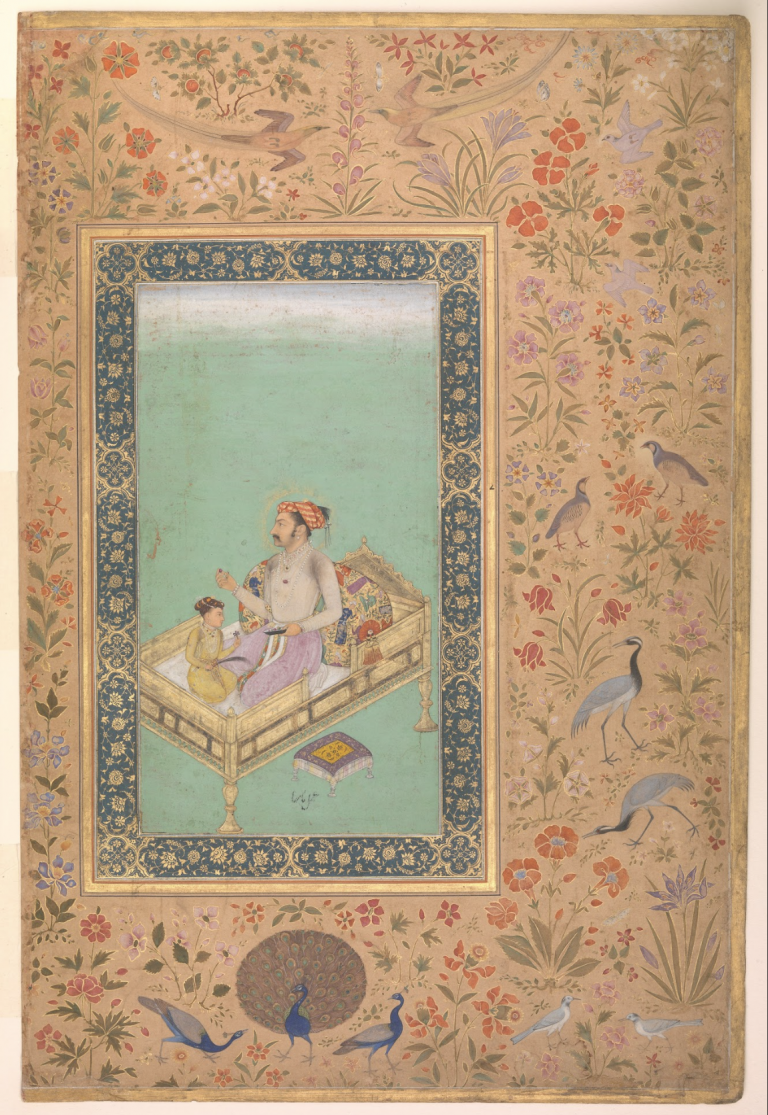Introduction text by Meera Menezes

He was one of the most significant painters of our age, yet he shunned the limelight. A reclusive master, who preferred the poetics of silence. Turning his gaze inwards, he sought a meditative space instead, expressing himself in the play of line, light and colour. While he turned towards a non-representational mode of painting, his canvases are imbued with a lyricism which draws the viewer in to explore their depths. Given his reticence, there is precious little documentation available on him. It is in this light that Pria Karunakar’s article on his work in the Lalit Kala Contemporary assumes significance. It also examines and contextualises his work at a certain point in history and time.

The first part of her article is devoted to the description of Gaitonde’s works focusing on his use of colour and texture. Karunakar dwells on the verticality of his paintings, which was an important element in his oeuvre. In an article in Thought in 1960 by eminent art critic Richard Bartholomew had also singled out this aspect of Gaitonde’s work. He wrote: “These vertical arrangements are essentially Gaitonde. The studs of colour form a spinal cord, and there is a vertebra of vibrancy”.
Karunakar, a poet and writer who wrote extensively on several Indian artists in the seventies, elucidates in her piece “The paintings do not gain from being shown consecutively; one does not lead into the next. It is more as if they are parallel essays under a single directive”. While this was her reading of his works, Gaitonde himself would have begged to disagree. In an interview to this author he had this to say “Every painting has a seed which germinates in the next painting. The painting is not limited to one canvas. I go on adding an element and that is how it evolves”.
Besides the well known influence of Zen on Gaitonde that she touches upon, Karunakar also mentions the influence of American colour field painting in his work. Artists of this school, like Mark Rothko, were interested in the effects these large swathes of colour had on the mood and atmosphere of a work. Gaitonde in his exploration of tonalities and luminosities appears to have done the same.

By far the most interesting aspect of Karunakar’s article is the comparison she draws between Nasreen Mohamedi and Gaitonde. While Gaitonde has often been compared with his contemporaries, the pairing with Nasreen might seem at first incongruous. Or on second thoughts perhaps not. For both of them had studios at the Bhulabhai Desai Institute in Mumbai which laid the ground for an interaction between them. Geeta Kapur in her essay in ‘Nasreen in Retrospect’ had this to say about the links between her and Gaitonde: “Bombay, her city has had an honourable record of both sumptuous and spare abstraction – among them Gaitonde, much older to Nasreen, acts as her Indian mentor in the early 1960s”.
Karunakar dwells on what unites both the artists, differentiating them from the mainstream of Indian abstraction at the time, just as much as she articulates their differences. By juxtaposing them she reveals new ways of reading their works, opening up unexplored avenues of dialogue in the process.
Pria Karunakar: V.S. Gaitonde
Lalit Kala Contemporary, Volume 18, pg 15 – 16
One hears comments on Gaitonde’s work: “It’s like the grain in a block of wood.”… “like smoke”… “like disintegrating leaves”.. “…an old wall that has suffered graffiti,” and more interestingly, “that red painting’’, it’s like exposed blood and bones and tissue: there’s an element of passion, somewhere.. A painter once commented on his sense of structure; “His work does not look constructed. It’s more like the result of some natural occurrence.”

The painter has arrived in one sense of the word. It has not been easy. Sometimes he sits surrounded by his canvas and looks at them. To him this is just as important as painting itself. He has no favourites among them. One returns to the canvases: They are sensuous. Each is unified by a single colour. The colour glows; it becomes transparent; it clots; It is this play of pigment, as it is absorbed physically into the canvas, that directs the eye. Texture is structure. How he achieves this texture is the secret of the Gaitonde style. The rest is simple.
The paintings do not gain from being shown consecutively; one does not lead into the next. It is more as if they were parallel essays under a single directive. All his paintings share an uncompromisingly vertical format. They cannot be seen from any other angle. In the application of the colour itself there is an order. This is hieratic, but implicit. It is never insistent. The colour settles and congeals into a series of approximate horizontals throwing the compositional weight somewhat lower than centre and balancing the left and the distribution of near–random forms across the surface. These topographical or hieroglyphic forms themselves are made to dissolve into the field like enamel in an encaustic.
The effect of these paintings is organic and frequently, but not always, quietistic (‘woodgrain’, ‘smoke’, ‘rotting leaves’.. blood’). The viewer is left with a feeling of refined sensuality. People frequently speak of Gai and Zen in the same breath. There is nothing “mystical” in the ordinary sense either in the work or in the painter’s intention. Where he does come close to Zen is in a certain terse concreteness (as in the finest haiku of Bassho). The paintings refer only to themselves. The process is the result. From this point of view he comes as close to the recent American preoccupation with colour-field as to Zen. Yet, just as Nasreen is not concerned with optics in the western sense, so Gaitonde’s consistent regard for formalism distinguishes his work the looser style of painters like Bhavsar or Olitsky.
Nasreen and Gai are two Indian painters whose work automatically separates itself from the mainstream of Indian abstraction at this time by a certain quality of objectivity, a sense of restraint and a degree of technical finish.
While most abstractions in this country start by breaking up a given object into planes or by an attempt to fracture the picture-plan or to impose on it a set of symbols, they do not. They accept space. For both, disciplined space-use means rhythm. From this point on, Nasreen has moved into a vocabulary of linear geometry, while Gai increasingly identifies himself with open–structuredness.
Both coincided with keen interest in the modulations of tone carried by a single surface. Nasreen has now broken this down almost chemically to black and white. Gai continues to explore the luminosities and densities of colour. Asa result he retains his hold on the relationship between colour and the strong psychosomatic pull it has on the viewer.
Important to the work of either artist is their personal understanding of the relationship between Random and Order: how far is the painter in conscious control of the work or to what degree does the medium itself determine what is being said. As Nasreen moves into fuller control of what he is doing, Gai’s greatest strength (and weakness) lies in the nature of his intuitive relationship with “controlled accident”. Yet there is a qualifying factor in this difference of emphasis. Nasreen’s use of mathematical proportions operates in so far as it uncovers new problems, new mysteries. So for Gai, the Romantic rather than the Classicist, more earth-bound than ascetic; his consistent values of professionalism and masterly obtain as he gets closer to the pictorial effect that he is moving towards.
The continual work of laying on pigment, dissolving it, stripping it off, and overlaying (like a process of nature) comes to a natural close as the pigmentation comes to a natural conclusion. The painter is at the controls, he decides when the painting has arrived at its capacity to articulate, yet he registers this intuitively: “Like music, I know when it is at an end.”

So far his visual sensibility has been absorbed in the action of the painting. Now it takes over and finalises. He takes his time about this. He lives with the painting; views it continually: “When your work takes over and obsess you, all things become the work…”
Yet infrequently it happens that the surface fails to assimilate its elements. The painting looks unfinished though the painter decides otherwise. In certain other paintings there is a conscious attempt to frame the event. Or, as in a brown on yellow painting of late ’74 with a vertical of alternating yellow and blue disks, patterns imposed later try to face an unnecessary “cohesion” on a surface that is already absorbed in itself. Why? Is this under-working or over-working a failure in timing merely; or is the painting making additional demands on the painter?
Gai is one who has finely trained his instincts and put them to work for him. But an instinct is not infallible. One is likely to learn as much about what he is after from his failures as from his successes. The painter is the same. The act of painting is the same. The formal ingredients are the same. The difference lies in the personal chemistry that makes an integral unity out of one painting and not another. This accounts for the sense of inevitability in his best work; one cannot visualise it in any other form than that in which it has been presented. When this collapses, so does the painting.
NOTE: The images are not those mentioned in article and are only used to illustrate the article.
Article Courtesy: Lalit Kala Akademi













